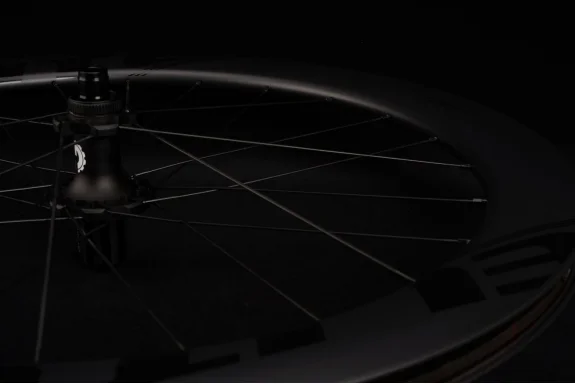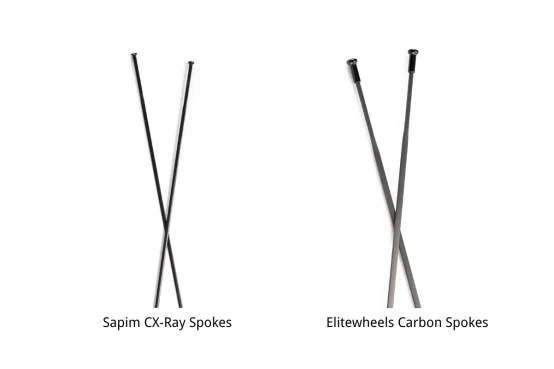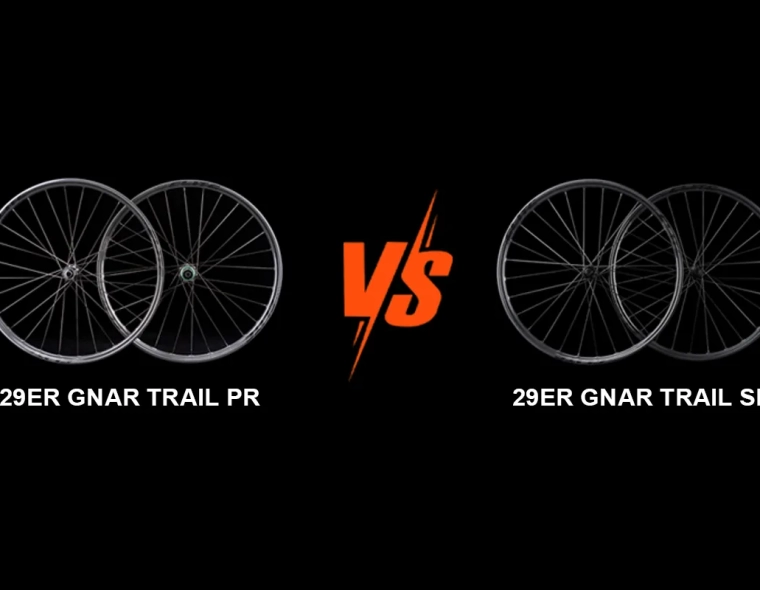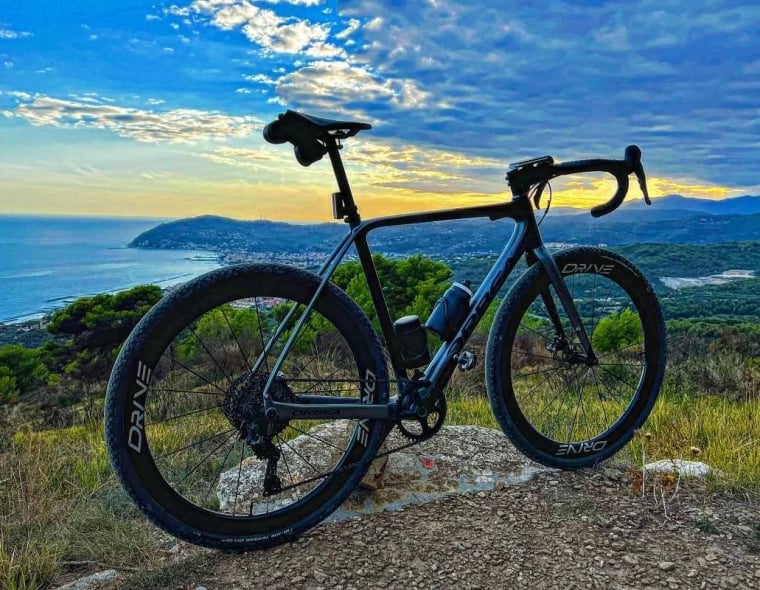There are two common types of spokes on the market: straight-pull spokes and J-bend spokes. While both have their unique advantages, choosing the right type can significantly affect factors like tension, durability, weight, and price. Moreover, the decision impacts how well a wheel performs on different terrains. This comprehensive guide aims to offer a deep dive into the differences between straight-pull and J-bend spokes across various metrics to help you make an informed choice.

Head Style of Spokes
The head style of a spoke is an important factor in how it attaches to the hub and affects the overall performance of the wheel. Different head styles are used for straight-pull and J-bend spokes, each with its own strengths and trade-offs.
Straight-Pull Spoke Head Design
Straight-pull spokes have a unique headless design compared to traditional J-bend spokes. They don’t feature the characteristic 90-degree bend, but instead connect directly to the hub, reducing stress at the junction between the spoke and hub flange. This results in more even tension distribution and fewer stress points.

T-Head Spokes
A variation of straight-pull spokes is the T-head spoke, which includes a T-shaped head that locks into a corresponding slot in the hub flange. This design prevents the spoke from twisting or rotating during wheel truing or under tension. The T-head design offers the same benefits as regular straight-pull spokes, including even load distribution and better tension management, but with added stability. Advantages of T-Head Spokes:
Prevents spoke rotation: The T-head helps secure the spoke in place, preventing unwanted movement during adjustments or under load.
Even tension: Like other straight-pull spokes, the absence of a bend allows for more even tension distribution across the spoke.
- head spokes are often found on high-performance wheelsets, especially in applications like road racing and mountain biking, where tension stability and durability are crucial.Check The Elitewheels Helix series The high-performance wheelsets features T-head carbon spokes with a 5.2mm width.

J-Bend Spoke Head Design
J-bend spokes feature a 90-degree bend at the head, forming a hook that sits inside the hub flange. This traditional design has been in use for decades and remains the most common spoke type due to its compatibility with a wide range of hubs and ease of maintenance. However, the bend can create a point of stress, which may lead to fatigue over time, particularly if tension is not managed properly. Advantages of J-Bend Spokes:
Widely available: Compatible with most hubs, making replacement easier.
Simple maintenance: Easier to work with and replace compared to straight-pull spokes, as J-bend spokes are more commonly stocked by retailers.
Both straight-pull and J-bend spoke head designs offer different benefits depending on the rider’s needs, with T-head spokes adding a layer of security and precision in high-performance scenarios.
Tension Management
How Tension Differs Between the Two
Tension is crucial in determining how well a wheel performs. Proper spoke tension ensures that the wheel stays true, balanced, and can handle the forces exerted on it during riding, especially on rough terrain or under heavy loads.
The straight-pull design offers several advantages when it comes to tension management. With no 90-degree bend, tension can be more evenly distributed along the entire length of the spoke. This is particularly beneficial in high-performance situations where precise tension is critical, such as in road racing or high-speed downhill riding. Straight-pull spokes often produce a more uniform tension, which translates into a stiffer, more responsive wheel. Elitewheels road, gravel and mtb wheels are all used straight-ful bladed spokes.
J-bend spokes are more prone to tension imbalances, especially near the bend. This area tends to accumulate more stress, which can lead to more frequent tension adjustments over time. However, when properly built, J-bend wheels can still offer excellent tension management. Advances in spoke materials and wheel-building techniques have reduced the historical downsides of uneven tension in J-bend wheels.

Influence on Wheel Performance
Wheels built with straight-pull spokes tend to be stiffer and more responsive, making them ideal for high-speed scenarios, where wheel flex can reduce performance. On the other hand, J-bend spokes, when properly tensioned, can deliver reliable performance but may not achieve the same level of stiffness. Endurance riders or those who prioritize comfort may prefer J-bend wheels because they can offer a more forgiving ride.
Durability
Stress Distribution and Fatigue Resistance
Durability is another critical factor, especially for cyclists who ride on challenging terrains or for extended periods. The material and design of spokes determine how well they distribute stress and resist fatigue over time.
Straight-pull spokes are often considered more durable because they eliminate the weak point at the bend. The absence of a 90-degree curve means that stress is distributed evenly along the length of the spoke, minimizing the chances of spoke breakage or fatigue failures. This feature makes straight-pull spokes more resilient under heavy loads or in conditions that demand consistent high performance.
The 90-degree bend in J-bend spokes introduces a stress concentration point. Over time, this can result in micro-cracks or fatigue, especially in low-quality spokes or poorly built wheels. However, advancements in spoke metallurgy and design have improved the durability of J-bend spokes. High-quality, double-butted J-bend spokes, when built by an expert, can last for thousands of miles without issue.
Longevity in Harsh Conditions
For riders tackling harsh conditions like gravel roads, muddy trails, or mountain biking, straight-pull spokes generally offer better long-term durability. They are less likely to fail under extreme stress or when subjected to the vibrations and impacts common in off-road cycling. J-bend spokes, while durable, may require more frequent inspections and adjustments to ensure their longevity.

Materials
Steel Sapim CX-Ray Spokes
Steel Sapim CX-Ray spokes and carbon spokes differ significantly in terms of material properties and performance characteristics. Steel spokes, such as the Sapim CX-Ray, are renowned for their durability and reliability. They offer excellent tensile strength and resistance to bending and breaking, which makes them a preferred choice for high-stress conditions, such as in competitive cycling and mountain biking. The steel construction provides a familiar feel and performance consistency, contributing to the overall robustness of the wheel. Additionally, steel spokes are generally less expensive compared to their carbon counterparts. Elitewheels Helix SS, Drive G45 SS, Marvel G35 are used Sapim CX-Ray spokes.
Carbon Spokes
On the other hand, carbon spokes are designed to be ultra-lightweight, offering a significant weight reduction advantage. This can lead to improved acceleration and climbing performance due to the reduced rotational mass. Carbon spokes also tend to have a more advanced aerodynamic profile, which can enhance overall aerodynamic efficiency. However, carbon spokes may be more susceptible to impacts and damage compared to steel spokes, and they typically come with a higher price tag. The choice between the two often comes down to balancing weight savings with durability and cost considerations. For carbon spoke wheelsets you can check Elitewheels Drive series.
Weight Considerations
Weight Differences Between Straight-Pull and J-Bend Spokes
Weight is always a critical factor in cycling performance, especially for competitive riders or those focused on optimizing efficiency. The overall weight of a wheelset, including the spokes, affects how the bike accelerates, handles, and performs on climbs.
Straight-pull spokes are often found on high-end lightweight wheelsets, as they are typically lighter compared to their J-bend counterparts. The hubs that accommodate straight-pull spokes are usually designed to minimize material usage, further reducing the overall weight of the wheelset. This can be especially advantageous for climbers or road cyclists who need every bit of efficiency.
J-bend spokes tend to be heavier, especially when built into traditional hubs. However, the weight difference is not always significant enough to be noticed by recreational riders. For casual riders or those focused on endurance rather than outright speed, the extra weight may be a minor consideration.
Impact on Riding and Acceleration
The lighter weight of straight-pull spokes can result in faster acceleration and better climbing performance, making them a favorite for competitive riders. However, the weight difference between high-quality J-bend and straight-pull spokes is often marginal, especially for non-racing cyclists. In everyday scenarios, aerodynamics and power output may have a greater influence on overall performance than spoke weight alone.
Price Comparison
Manufacturing Costs
One of the most noticeable differences between straight-pull and J-bend spokes is the cost. Straight-pull spokes are generally more expensive, and this is due to several factors, including:
Complexity of manufacturing: Straight-pull hubs require more precision in their construction, driving up costs.
Target market: Straight-pull spokes are often found on premium wheelsets designed for high-performance riding, further increasing their price.
J-bend spokes, by contrast, are widely available and less expensive to produce. They have a long history of use and benefit from economies of scale in manufacturing.
Long-Term Investment
While straight-pull spokes are more expensive initially, they may offer better long-term value for cyclists who demand high performance. Their improved durability and better tension management can mean fewer maintenance issues and spoke replacements over time.
K-bend spokes offer a cost-effective solution for riders who don’t require the absolute highest performance. They are easier to find and replace, and the initial cost savings can be appealing to casual or budget-conscious cyclists.

Terrain Suitability
Different types of spokes are better suited for certain terrains. Both straight-pull and J-bend spokes excel in specific environments based on their strengths in tension, durability, and overall performance.
Ideal Terrain for Straight-Pull Spokes
Road cycling: The stiffness and responsiveness of straight-pull spokes make them ideal for road racing or long-distance touring on smooth surfaces.
Downhill mountain biking: Riders who need stiffness and resilience under high-speed, high-impact conditions often prefer straight-pull spokes.
Cross-country mountain biking: The weight savings and durability help riders tackle long distances and varied terrain.
Straight-pull spokes are favored for performance-driven disciplines that require a stiff, lightweight wheel capable of withstanding intense stress.
Ideal Terrain for J-Bend Spokes
Gravel riding: J-bend spokes, with their slightly more forgiving tension management, are excellent for gravel or mixed-terrain rides where comfort is a priority.
Endurance riding: The slight flex and comfort provided by J-bend spokes can be an asset for long-distance riders.
Recreational mountain biking: For those who don’t need the stiffness and high performance of straight-pull spokes, J-bend wheels offer more than enough durability and strength for casual off-road riding.
Conclusion
The choice between straight-pull and J-bend spokes depends largely on your cycling goals, maintenance preferences, and budget. Straight-pull spokes offer better tension management, reduced weight, and improved durability, making them ideal for performance-oriented cyclists. J-bend spokes, on the other hand, offer an affordable, versatile option that’s easy to maintain and well-suited for a wide variety of riding conditions.
Whether you’re a competitive racer looking for every possible performance advantage or a casual rider who prioritizes cost and ease of maintenance, understanding the nuances between these spoke types will help you make the right choice for your wheels.




